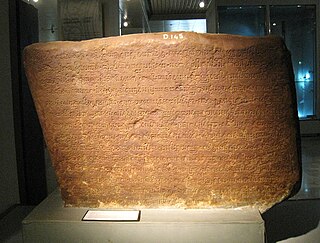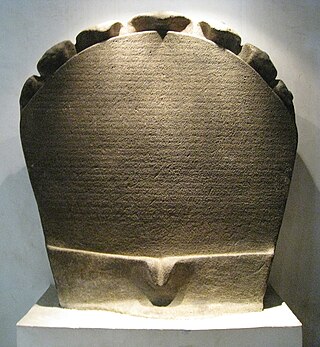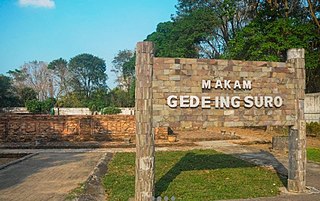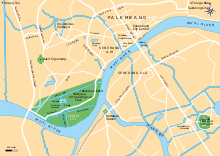
Palembang is the capital city of the Indonesian province of South Sumatra. The city proper covers 352.51 square kilometres on both banks of the Musi River in the eastern lowlands of southern Sumatra. It had a population of 1,668,848 at the 2020 Census; the official estimate as at mid 2023 was 1,772,492. Palembang is the second most populous city in Sumatra, after Medan, and the twelfth most populous city in Indonesia.

Srivijaya, also spelled Sri Vijaya, was a Hindu-Buddhist thalassocratic empire based on the island of Sumatra that influenced much of Southeast Asia. Srivijaya was an important centre for the expansion of Buddhism from the 7th to 11th century AD. Srivijaya was the first polity to dominate much of western Maritime Southeast Asia. Due to its location, Srivijaya developed complex technology utilizing maritime resources. In addition, its economy became progressively reliant on the booming trade in the region, thus transforming it into a prestige goods-based economy.

South Sumatra is a province of Indonesia, located in the southeast of the island of Sumatra. The capital and largest city of the province is the city of Palembang. The province borders the provinces of Jambi to the north, Bengkulu to the west and Lampung to the south, as well a maritime border with the Bangka Belitung Islands to the east. It is the largest province in the island of Sumatra, and it is slightly smaller than Portugal, the department of Boquerón in Paraguay or the U.S. state of Maine. The Bangka Strait in the east separates South Sumatra and the island of Bangka, which is part of the Bangka Belitung Islands province. The province has an area of 91,592.43 km2 (35,364 sq mi) and had a population of 8,467,432 at the 2020 census; the official estimate as at mid-2023 was 8,743,522. The province is rich in natural resources, such as petroleum, natural gas and coal. The province is inhabited by many different Malay sub ethnic groups, with Palembangese being largest ethnic group. Most speak the Palembang language, which is mutually intelligible to both Indonesian and local Palembang Malay. Other ethnic groups include the Javanese, Sundanese, Minangkabau and Chinese. Most are concentrated in urban areas and are largely immigrants from other parts of Indonesia.

The Musi River is a river in Southern Sumatra, Indonesia. It flows from south-west to north-east, from the Barisan Mountains range that form the backbone of Sumatra, in Kepahiang Regency, Bengkulu Province, to the Bangka Strait that forms an extension of the South China Sea. The Musi is about 750 kilometers long, and drains most of South Sumatra province. After flowing through Palembang, the provincial capital, it joins with several other rivers, including the Banyuasin River, to form a delta near the town of Sungsang. The river, dredged to a depth of about 8 meters, is navigable by large ships as far as Palembang, which is the site of major port facilities used primarily for the export of petroleum, rubber and palm oil.

Tarumanagara or Taruma Kingdom or just Taruma was an early Sundanese Indianised kingdom, located in western Java, whose 5th-century ruler, Purnawarman, produced the earliest known inscriptions in Java, which are estimated to date from around 358 CE.

Pugung Raharjo is a 30 hectares archaeological site in the regency of East Lampung regency of Lampung Province in South Sumatra in Indonesia. The site was discovered in 1957. There is an ancient terraced megalithic structure, also known as Pugung Raharjo Pyramid. There other megalithic structures from the 12th to 16th century CE, including Menhirs and Dolmen, as well as prehistoric remains dating back to 2500 BC. It is locally known as the "Taman Purbakala Pugung Raharjo". It is situated approximately 50 km from the provincial capital, Bandar Lampung.

Muaro Jambi is a Buddhist temple complex, in Muaro Jambi Regency, Jambi province, Sumatra, Indonesia. It is situated 26 kilometres (16 mi) east from the city of Jambi. The temple complex was built by the Melayu Kingdom, with its surviving temples and other archaeological remains estimated to date from the 7th to 13th century CE. The archaeological site includes eight excavated temple sanctuaries and covers about 12 square kilometres (4.6 sq mi), stretches 7.5 kilometres (4.7 mi) along the Batang Hari River, 80 menapos or mounds of temple ruins, are not yet restored. It is one of the largest and best-preserved ancient temple complexes in South East Asia.

Bukit Seguntang or Bukit Siguntang is a 29–30 metres high small hill located at the northern bank of Musi River and within the vicinity of Palembang, capital city of South Sumatra, Indonesia. It is located around 3 kilometres north from Musi River northern bank and around four kilometres southwest from Palembang city center. The place is considered sacred by the locals and home of many archeological relics believed to be related to Srivijaya, once a dominating political power around Malacca Strait. Today the hill holds the title of an archaeological park.

Military Region Command II/Sriwijaya is an Indonesian Army Regional Military Command that covers the provinces of Bengkulu, Jambi, South Sumatra, Bangka-Belitung Islands and Lampung.

Telaga Batu inscription is a 7th-century Srivijayan inscription discovered in Sabokingking, 3 Ilir, Ilir Timur II, Palembang, South Sumatra, Indonesia, around the 1950s. The inscription is now displayed in the National Museum of Indonesia, Jakarta, with inventory number D.155. In previous years, around thirty Siddhayatra inscriptions were discovered around Southern Sumatra, all concerning the Siddhayatra journey of Dapunta Hyang Sri Jayanasa, which, according to Kedukan Bukit Inscription took place around the year 605 Saka. Today all of these Siddhayatra inscriptions are stored in the National Museum of Indonesia.

Pannai, Panai or Pane was a Buddhist kingdom located on the east coast of Northern Sumatra that existed between the 11th and 14th centuries. The kingdom was located on the Barumun River and Panai River valleys, in today's Labuhan Batu and South Tapanuli regencies. Because surviving inscriptions and historical records of this period are scarce, the kingdom is among the least known political entities in Indonesian history. Historians suggest that Pannai was probably a principality or a vassal allied under the Srivijayan mandala and later to Dharmasraya kingdom.

The archaeology of Indonesia is the study of the archaeology of the archipelagic realm that today forms the nation of Indonesia, stretching from prehistory through almost two millennia of documented history. The ancient Indonesian archipelago was a geographical maritime bridge between the political and cultural centers of Ancient India and Imperial China, and is notable as a part of ancient Maritime Silk Road.

Balaputradeva Museum, officially the State Museum of South Sumatra Province "Balaputradeva", is an ethnographic museum located in Southern Sumatra's capital Palembang. The museum is the state museum of the Province of South Sumatra. The name Balaputradeva is derived from Balaputra, a 9th century sovereign of Srivijaya kingdom and the former head of the Sailendra dynasty whose main center was located in the vicinity of Palembang. Balaputradeva Museum displays the history and traditions of the province of South Sumatra.

Sultan Mahmud Badaruddin II Museum is a municipal museum in Palembang, Indonesia. The museum is established inside a 19th-century building former of the office of the colonial resident of South Sumatra. The building also houses the tourist department of Palembang.

Kuto Besak, also Benteng Kuto Besak is an 18th-century kraton in Palembang, South Sumatra. Kuto Besak was the center of the Sultanate of Palembang before its abolition by the Dutch colonial government. The fort was constructed in 1780 and took seventeen years to complete. Kuto Besak was inaugurated in 1797, marked by the transfer of the royal residence from the older Kuto Lamo to Kuto Besak.

The Sultanate of Palembang Darussalam was a sultanate in Indonesia whose capital was the city of Palembang in the southern part of the Indonesian island of Sumatra. It was proclaimed in 1659 by Susuhunan Abdurrahman (1659–1706) and dissolved by the colonial government of the Dutch East Indies on October 7, 1823. In 1825, its last ruler, Sultan Ahmad Najamuddin, was arrested and sent into exile on the island of Banda Neira in the Moluccas.
The Cirebon shipwreck is a late 9th to 10th-century shipwreck discovered in 2003, in the Java Sea offshore of Cirebon, West Java, Indonesia. The shipwreck contains a large amount of Chinese Yue ware, and is notable as important marine archaeology evidence of the Maritime Silk Road trading activity in Maritime Southeast Asia.

Bumiayu temple compound, or locally known as Candi Bumiayu, is a Sumatran Shivaist Hindu temple complex located near the banks of Lematang river, precisely in Bumiayu village, Tanah Abang district, Penukal Abab Lematang Ilir Regency, South Sumatra, Indonesia. The temple located about 120 kilometres west of Palembang city. The red brick structures are estimated dated from 8th to 13th-century, and linked to the Srivijaya kingdom. Compared to Java, only a few Hindu-Buddhist temple ruins has been rediscovered in Sumatra. The temple is known as one of the few surviving Hindu temple remnant in South Sumatra. Other temple ruins in Sumatra are Muaro Jambi in Jambi, Muara Takus in Riau, and Bahal temple in North Sumatra.

Geding Suro is a cemetery complex with the oldest history in Palembang, Indonesia. The complex, which is located at 3 ilir Palembang, is an Islamic cemetery from the mid-16th century with 8 buildings and 38 burials. There were a total of 38 ancient graves discovered there, Ki Gede Ing Suro is one of the historical figures interred at the cemetery complex, which was constructed about the middle of the sixteenth century.

Mataram–Srivijayan wars, also called as Pralaya in Javanese inscription of Pucangan, were a military engagements between two rival kingdoms of the Srivijaya of Shailendra and Mataram kingdom of Ishana, intermittently from c. 937 when the Srivijayan forces attempted to approach the Mataram capital, until 1016 when the kingdom of Mataram was collapsed due to a rebellion incited by Srivijaya.





















